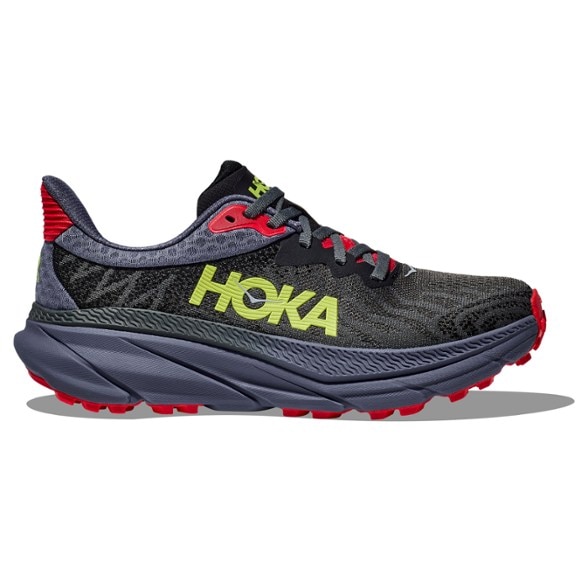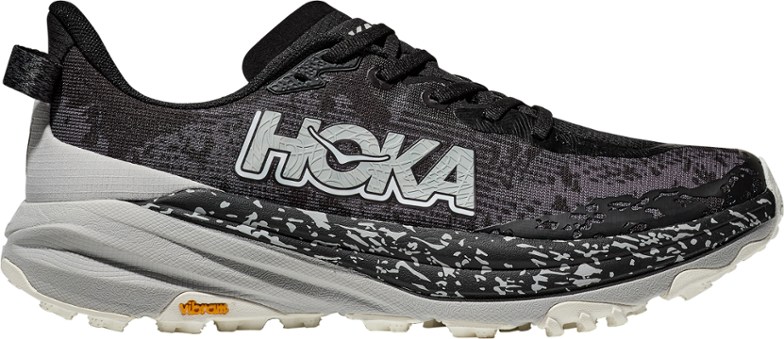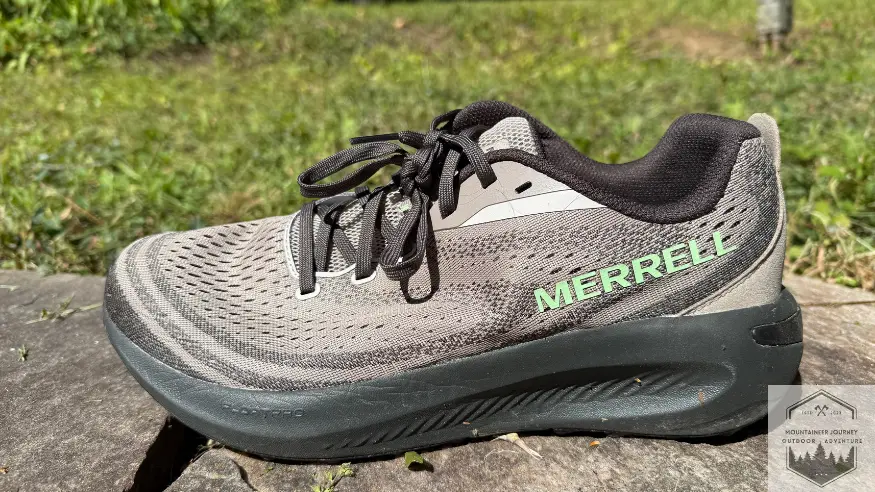Hoka Challenger 7 Review | Worth It In 2025?

In this article, I’m going to share my HONEST Hoka Challenger 7 review for those who are wondering whether they are still WORTH IT in 2025. As a seasoned trail runner with over 12 years of experience testing trail running shoes, I recommend these for runners looking for an extremely lightweight, and stable trail runner.
For this review, I have put in over 50+ miles into testing my own personal pair of the Challenger 7 throughout 2023 into 2025.
I’m very familiar with how they feel and perform on the trails. I’ll go over comfort/fit , traction, stability & support , weight, overall protection, and durability. I’ll be giving a score of each category based on OBJECTIVE testing standards and an overall score with recommendations at the end.
Released in 2023, the Challenger 7 impressed trail runners due to the lightweight construction and Hoka staple comfort. Compared to the Challenger 6, the upgrades consisted of a more comfortable footbed, improved mesh outer, and cut off an oz per pair.
Watch this Full Review on YouTube!
Challenger 7 Pros and Cons
- Fits true to size, no break-in period required
- Excellent torsional rigidity in the heel
- Good responsiveness in midsole
- Only 10 oz
- Performs better than most trail runners on pavement
- Too soft for VERY technical terrains
- Lugs will tend to wear quicker than other models
Should you buy the Hoka Challenger 7?

Buy if
- You want one of the most COMFORTABLE Trail Runners on the market
- You want an extremely lightweight pair of trail runners
- You are looking for a heavily cushioned trail runner
- You want a trail runner that has a moderate heel-to-toe drop
DON’T Buy if
- You prefer traditional stitching with no welded materials
- You want the Vibram Megagrip outsole
- Extreme durability with a stiff outsole
Compare To Similar Products

Top-rated trail running shoe for light to moderate trail runners. Excellent cushioning and fit. Does not appeal to the hardcore trail runner.

One of the best overall trail runners. Excellent on-trail performance with waterproofness. Improved from previous model

Hoka Challenger 7 Price

Right now, the Challenger 7 retails for $145, but I found some awesome deals on Hoka.com for as low as $116.
Get The BEST deal on the Hoka Challenger 7 at the LOWEST Price Available! (Do NOT pay retail):
Disclosure: These links may provide a discount and in return, give us a commission in order to run the website 🙂
Hoka Challenger Comfort & Fit : 9/10 (20%)

When I first tried on the Challenger 7, I felt the familiar cushioning of most Hoka shoes. My foot sank into the footbed nice and easy. I didn’t feel any immediate areas of compression.
The midsole cradled my foot without being overly compressive, this was very comparable to the Salomon Speedcross 6. The trail runner itself is one of the most comfortable I have tested to date.
I was able to perform a mile run right out of the box, I didn’t feel any hot spots or blisters, there was absolutely no break in period. Normally I would get blisters with most trail runners, not with this model the heel is nice and wide.

The toe box I measured at 3.35 in it was just wide enough for my toes to splay out and give a nice wide, stable base. The inner lining of the shoe was nice and sleek without any scratchy overlays.
The tongue is nice and well-padded, I felt a little area of pressure at the top of my foot with the tongue but that went away after 1 mile in.
The upper is much more comfortable when compared to the Speedgoat 6, the mesh is much more flexible and conforming rather than stiff and static like in the Speedgoat 6.
I didn’t have to perform any specialized lacing techniques, my heel was locked in with a nice tight fit. I wore a size 10.5 men’s, I didn’t feel the need to size up or down with this model.
Thanks to the Compression molded EVA midsole, the shock absorption is outstanding. While you are pounding your ankles and knees with other trail runners, the Challenger 7 gives you more cushion than any other trail runner absorbing the impact of each stride.
Overall, the comfort and fit of the Challenger 7 is one of the best on the market, don’t forget about the shock absorption and no need for a break-in period.
Traction: 8.5/10 (20%)

The Hoka Challenger 7 is not equipped with the Vibram Megagrip outsole, unlike most trail runners made by Hoka. The outsole is Durabrasion, which is much lighter and softer than the Vibram outsole.
The lugs are 4mm and well spaced apart. The traction of the Challenger does extremely well on light to moderate terrain , as well as asphalt. The traction starts to lose its fine grip on more technical terrain, and very steep inclines.
While testing the Challenger on wet technical terrain, it started to show its downside. I felt some slipping, especially on wet sandstone, and snow. While it does great on dry terrain, the outsole and lugs are not stiff enough to withstand uneven, wet terrain.
Transitioning terrain from road to gravel or dirt is where the 7 really differentiates itself from the crowd. The outsole is soft and grippy enough for trail running, while versatile enough for road running.
That being said, using this shoe on pavement or asphalt will prematurely wear the outsole just like any trail running so do so at your discretion.
Hillside running is something the Challenger 7 dominates in. The high heel stack absorbs shock while on a steep incline like no other, and the soft durabrasion outsole conforms under pressure giving you that grip you need on steep hillsides.
The durabrasion outsole is definitely softer than most, and will put an earlier lifetime on the shoe in terms of traction and grip.
Overall, the Challenger 7 has some of the best traction for versatile terrain. It is one of the best trail runners for both pavement and trails, while it is not the best for heavy technical terrain.
Stability & Support 8.5/10 (20%)

The wide base of the Challenger makes up for the soft outsole and lugs, it gives a nice planted feel especially while tackling descents.
My upper hugs the foot without creating compression, but securing my foot in place inhibiting any internal movement. This is essential for keeping internal stability of the shoe without compromising fit or comfort.
I noticed my forefoot stability is not as robust going over 15% grade inclines, this is because of the soft outsole. My forefoot cushion began to compress too much under this pressure, therefore I didn’t feel as much security on more severe inclines and technical terrain.
The torsional stability of the Challenger 7 is moderate, while it has enough “give” in the forefoot to flex side to side the heel is much more stiff leading to a flex throughout my gait.
I measured the heel-to-toe drop at 5 mm which was great for me, as I am a more midfoot striker. Increasing the heel-toe-drop in this model would severely hurt its performance on steep terrain, I am still ankle to get great plantar flexion of the forefoot and midfoot on steeper terrain.
The Challenger 7 offers Stability and Support you won’t see with any other trail runner models. They were able to strike an appealing balance of midfoot and heel stability while keeping the stack height high, and outsole soft. While the stability and support begins to waver on steeper inclines, it still passes the test for versatility.
Weight 8.5/10 (15%)

The Challenger 7 is one of the lightest trail runners I have personally tested to date. I weighed my men’s 10.5 at 10 oz flat. Somehow, Hoka was able to feature a high stack height with excellent cushioning while keeping the weight down.
The Challenger is even lighter than the Non-gore tex version of the Speedgoat 5 which I weighed at 11 oz , the same size as well.
I felt Hoka really kept the ultra lightweight of this trail runner of the previous model, while upping the performance.
How’s The Overall Protection Of The Challenger 7?

The Hoka Challenger 7 does not incorporate a rock plate for extra protection, with the added soft outsole this does not make for a great combination.
That being said, the high stack height and cushion help you from feeling the rock hard, uneven ground. While this is a trade off for those training for feedback, it meets a nice even point for protection.
There is a nice rubber toe cap, preventing you from hitting any sharp or hard objects when zooming through the trails, the toe cap is much more robust than most trail runners.
The sides of the shoe are pretty flimsy, as most trail runners are. You are definitely at risk of any sharp objects piercing the sides of your shoe.
For a soft outsole and no rock plate, the Challenger bodes well for overall protection, it definitely surprised me when testing on the trail.

The Challenger 7 I tested was the non-gore tex version. Due to the high stack height, you have about 1.5 inches before any water gets into your shoe from my testing. You can get away with small water crossings with the high outsole of this shoe, otherwise I recommend the GTX version.
Hoka Challenger Overall Protection 7/10 (10%)
Durability 6.5/10 (10%)

I have durability concerns with the Hoka Challenger 7. The outsole is very soft, as well as the lugs. I haven’t noticed any wear on the lugs but they are definitely not as robust as the Salomon Speedcross or S/Lab Ultra. Expect to get your money’s worth out of the grip, but once it starts to wear the performance will dip tremendously.
The Challenger 7 is definitely made from quality materials. The upper and mid is mainly welded together. This is to keep the weight low, welded materials are a trail runner standard however tend to wear quicker than traditional stitching.
Overall, I have not personally experienced any durability issues with the Challenger 7 at 50+ miles. However, expect the softer outsole to wear quicker than most models. We will update this category with continued testing and any more durability results.
Is the Hoka Challenger 7 worth it?

If you are looking for a versatile trail runner with extreme comfort, and performance the Hoka Challenger 7 definitely meets those expectations.
As a high-performance trail runner, the Challenger 7 is not the best for technical terrain. However, for mild to moderate terrain, and for running on pavement, and asphalt it is one of the best.
You’d be hard-pressed to find a better trail runner for under $145.
The strengths of this shoe is the comfort, stability, traction, and price!
The drawbacks to consider would be there are more performance based models out there for more technical terrain runners such as the Brooks Cascadia 18 or Salomon Speedcross 6. Also for runners looking for better durability check out the Speedgoat 6.
As an affordable option for weekend trail adventures, the Challenger 7 is tough to beat
Value: 4.5/5 (5%)
Scoring Breakdown
Comfort & Fit (20%): 9/10
Traction (20%) : 8.5/10
Stability & Support (20%): 8.5/10
Weight (15%) : 8.5/10
Overall Protection (10%) : 7/10
Durability (10%) : 6.5 / 10
Value (5%) : 4.5 / 5
Total Weighted Score :1.80 + 1.70 + 1.70 + 1.275 + 0.70 + 0.65 + 0.45 = 8.275 / 10 = 8.3 / 10
Our Rating: 8.3 / 10

At the time of this writing, the Challenger 7 retails for $145, but I found some awesome deals on Hoka.com for as low as $116.
Get The BEST deal on the Hoka Challenger 7 at the LOWEST Price Available! (Do NOT pay retail):
Frequently Asked Questions
What Are The Hoka Challenger 7 Good for?
The Hoka Challenger 7 are excellent for mild to moderate trail running, and running on pavement. They are not so great for technical terrain.
Can You Wear The Hoka Challenger 7 On The Road?
Yes! You can absolutely wear the Hoka Challenger 7 on the road. With the soft outsole, it mimics some attributes of a running shoe. It makes a great versatile trail runner you can use on the road.
Does Hoka Challenger 7 have a wide toe box?
Yes, the Challenger 7 has a wider toe box than most trail runners. I measured the toe box with my caliper at 3.35 inches, higher than the average trail runner toe box.
Is The Challenger 7 Good For Plantar Fasciitis?
Yes, I didn’t notice any flare ups of my plantar fasciitis while testing out the Challenger 7. The heel-to-toe drop of 5mm definitely takes pressure off the arch and the heel, preventing flare ups.
How We Tested and Our Methodology

I personally tested the Hoka Challenger 7 over three years since their release in 2023 with the sole intent of giving you the most unbiased review possible. Mountaineer Journey is a 100% independent publisher with years of testing and reviewing outdoor equipment.
Over the past 15+ years, I’ve logged thousands of trail miles across everything from smooth single-file roads to steep, technical singletrack. This includes long-distance runs in the Rockies, muddy East Coast climbs, loose desert terrain, and fast descents through alpine switchbacks.
This kind of hands-on experience helps me evaluate how a trail running shoe truly performs—whether it’s truly stable, grips well on varied surfaces, and holds up over time under real mileage.
We currently pay for the products we test ourselves; no company or manufacturer pays us to sway our opinions or decisions.
Adventure Awaits,
Tyler








